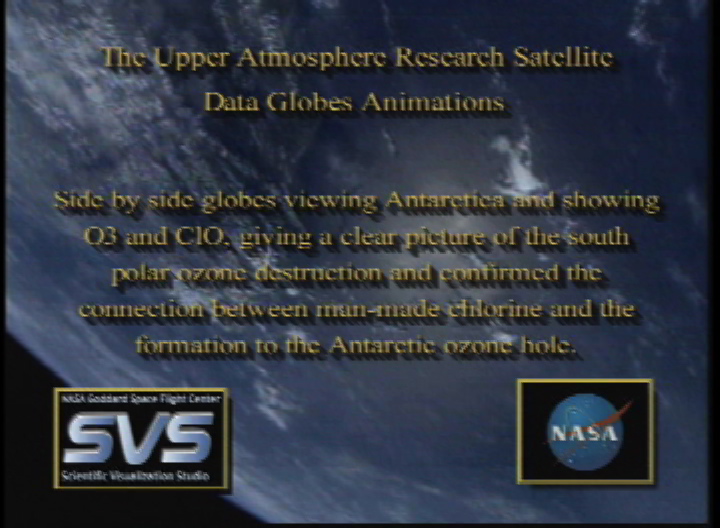Earth
ID: 837
The Microwave Limb Sounder (MLS) measures microwave emission from ozone and chlorine monoxide, a major ozone destroying radical. Right after UARS was launched, MLS began to measure large concentrations of chlorine monoxide over the south pole. These dramatic images clearly showed the extent of the south polar ozone destruction and confirmed the connection between man-made chlorine and the formation to the Antarctic ozone hole. Why is so much chlorine monoxide found over the Antarctic? UARS measurements have confirmed that CFCs enter the stratosphere in the tropics. As they rise above the ozone layer, ultraviolet molecules release chlorine, which then can react with methane to form hydrogen chloride. Chlorine can also react with ozone forming the radical chlorine monoxide. Chlorine monoxide then combines with the radical nitrogen dioxide to form stable chlorine nitrate. Chlorine nitrate and hydrogen chloride are called reservoir gases for the chlorine radical. These reservoir gases usually contain more than ninety percent of the chlorine in the lower stratosphere.

Ozone and Chlorine Monoxide over Antarctica from MLS (1/12/93 - 9/17/93)

For More Information
Visualization Credits
Please give credit for this item to:
NASA/Goddard Space Flight Center Scientific Visualization Studio
NASA/Goddard Space Flight Center Scientific Visualization Studio
Short URL to share this page:
https://svs.gsfc.nasa.gov/837
Mission:
Upper Atmosphere Radiation Satellite (UARS)
Data Used:
Note: While we identify the data sets used in these visualizations, we do not store any further details nor the data sets themselves on our site.
This item is part of this series:
UARS
Keywords:
DLESE >> Atmospheric science
DLESE >> Chemistry
SVS >> Chlorine Monoxide
DLESE >> Climatology
GCMD >> Earth Science >> Atmosphere >> Atmospheric Chemistry/Oxygen Compounds >> Ozone
GCMD >> Location >> Antarctica
NASA Science >> Earth
GCMD keywords can be found on the Internet with the following citation: Olsen, L.M., G. Major, K. Shein, J. Scialdone, S. Ritz, T. Stevens, M. Morahan, A. Aleman, R. Vogel, S. Leicester, H. Weir, M. Meaux, S. Grebas, C.Solomon, M. Holland, T. Northcutt, R. A. Restrepo, R. Bilodeau, 2013. NASA/Global Change Master Directory (GCMD) Earth Science Keywords. Version 8.0.0.0.0
https://svs.gsfc.nasa.gov/837
Mission:
Upper Atmosphere Radiation Satellite (UARS)
Data Used:
UARS/MLS
1993/8/12-1993/9/17This item is part of this series:
UARS
Keywords:
DLESE >> Atmospheric science
DLESE >> Chemistry
SVS >> Chlorine Monoxide
DLESE >> Climatology
GCMD >> Earth Science >> Atmosphere >> Atmospheric Chemistry/Oxygen Compounds >> Ozone
GCMD >> Location >> Antarctica
NASA Science >> Earth
GCMD keywords can be found on the Internet with the following citation: Olsen, L.M., G. Major, K. Shein, J. Scialdone, S. Ritz, T. Stevens, M. Morahan, A. Aleman, R. Vogel, S. Leicester, H. Weir, M. Meaux, S. Grebas, C.Solomon, M. Holland, T. Northcutt, R. A. Restrepo, R. Bilodeau, 2013. NASA/Global Change Master Directory (GCMD) Earth Science Keywords. Version 8.0.0.0.0











